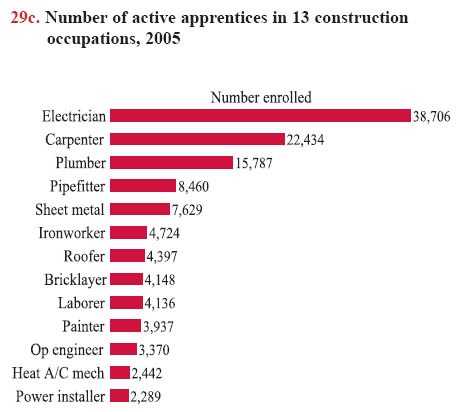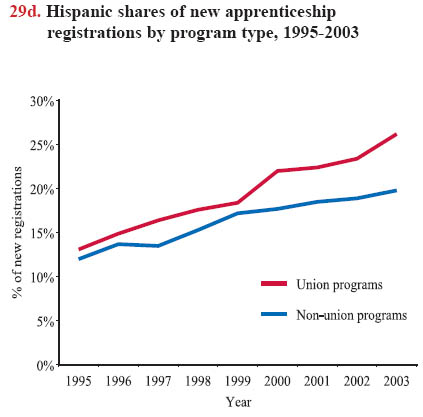Summary Statement
A broad collection of tables and charts covering health and safety in the U.S. construction industry, as well as considerable economic and training data.
2007
Section 29: Apprenticeships in Construction
Apprenticeships are important in construction because the work is craft-based, relying on skilled workers who have a great deal of autonomy. Many people enter construction crafts through apprenticeship programs, which offer on-the-job training under the close supervision of a craftworker, along with formal classroom instruction. Construction apprenticeships generally take three to five years, depending on the occupation (see Annex 2).
The Bureau of Apprenticeship Training at the U.S. Department of Labor sets quality standards that require apprenticeships registered with the federal government to include at least 1 year or 2,000 hours of on-the-job training and recommend 144 hours of formal instruction.1 Apprenticeship programs are sponsored either jointly by labor unions and contractors signatory to a collective bargaining agreement in the organized sector, or unilaterally by contractors in the non-union sector. For labor management apprenticeship training programs, a training fund is usually established in the collective bargaining agreement with the employer, and each contractor signatory to a local union pays into that fund. The fund dollars are managed through a joint trust fund with labor and management representatives. The apprenticeship program is run by the union with trained instructors teaching in regional centers; the program also provides hundreds of hours of on-the-job experience for apprentices. These union apprenticeship programs differ from employer-sponsored programs, which are organized and managed by individual contractors in the non-union sector.Joint labor-management apprenticeship training programs are major providers of skilled labor. According to the data tracked by the Department of Labor's Office of Apprenticeship Training, Employer and Labor Services, from 1995 to 2003, for the 31 states for which data are available, around 70% of apprentices were enrolled in the joint labor-management programs.2 The overall number of new registrations increased from 33,245 in 1995 to 70,528 in 2001, and then dropped to 61,404 in 2003, coinciding roughly with recessions (chart 29a). The distribution of new registrations between the union and non-union programs was relatively stable over these years. The shares of joint programs were highest in Missouri (90.1%), Nevada (89.3%), West Virginia (88.2%), California (87.9%), Pennsylvania (83.1%), and Illinois (81.2%, chart 29b), reflecting relatively strong union market shares in these states (see chart book page 11).
In addition to a higher enrollment rate, the completion rate appears to be higher for the labor-management programs than the non-union programs. For example, in the 1995-1997 cohort, labor-management programs accounted for two-thirds of all graduates from 8,000-hour programs and 88% of all graduates from 6,000-hour programs. Among women apprentices, the completion rate was 30.4% in labor-management programs compared with 20.8% in employer-sponsored programs for the same cohort. Among apprentices who registered in 1995 to 1997 for 8,000 hour programs, about 45.4% of 36,317 apprentices in union programs completed the program, while 31.5% of 27,586 apprentices in non-union programs did, which made the completion rate in the union programs about 14 percentage points higher than the non-union programs.
Apprenticeship programs are organized in more than 500 occupations in the construction industry. When apprenticeship numbers are compared with occupational distributions in construction (see chart 10b), certain trades demonstrate higher numbers of apprenticeships than others (chart 29c).3 One reason may be trades with certification requirements, such as electricians, tend to have higher rates of apprenticeships. Labor-management and employer-sponsored programs differ in types of occupational training. For example, structural steel work and operating engineer registrations were almost exclusively in labor management programs. Generally, employer-only programs were concentrated in a few occupations, whereas joint apprenticeship training programs were active in a greater variety of occupations.
In recent years, the proportion of new registrations of Hispanic origin increased with rapidly rising Hispanic employment in the construction industry (see chart book pages 15 and 16). The number of Hispanic registrations doubled between 1995 and 2003. The Hispanic representation in labor-management programs was much higher than in non-union programs, and the difference was even larger after 2000 (chart 29d). In contrast, the share of African Americans remained stable at around 9%, and slightly decreased during this time period. The number of Hispanic apprentices was highest in roofing and painting, while African Americans were heavily represented in roofing and operating engineer occupations. The share of women in construction apprenticeship registration was not only low, but declined in recent years, from 4.4% in 1995 to 2.6% in 2003.




Download MS PowerPoint versions of Charts
1. U.S. Department of Labor, Office of Apprenticeship Training, Employer and Labor Services/Bureau of Apprenticeship and Training.
2. Cihan Bilginsoy. Registered apprentices and apprenticeship programs in the U.S. construction industry between 1989 and 2003: an examination of the AIMS, RAIS, and California apprenticeship agency databases. Working Paper No: 2005-09, University of Utah, Department of Economics, May 2005. Statistics used on this page were from this paper except where noted.
3. U.S. Department of Labor, Employment and Training Administration. Top 25 Apprenticeship Occupations Ranked by Total as of September 30, 2005.
Note:
Charts 29a, 29b, and 29d - The data do not reflect the entire registered apprenticeship system or provide a nationally representative sample. The District of Columbia, Puerto Rico, the Virgin Islands, and the following 19 states do not participate in the Apprenticeship Information Management System (AIMS) used for these charts: Connecticut, Delaware, Hawaii, Kansas, Kentucky, Louisiana, Maine, Maryland, Massachusetts, Minnesota, New Hampshire, New York, North Carolina, Oregon, Rhode Island, Vermont, Virginia, Washington, and Wisconsin.
Source:
Charts 29a, 29b, and 29d - Cihan Bilginsoy. Registered apprentices and apprenticeship programs in the U.S. construction industry between 1989 and 2003: an examination of the AIMS, RAIS, and California apprenticeship agency databases. Working Paper No: 2005-09, University of Utah, Department of Economics, May 2005.
Chart 29c - U.S. Department of Labor, Employment and Training Administration. Top 25 Apprenticeship Occupations Ranked by Total as of September 30, 2005.
Back to Table of Contents


